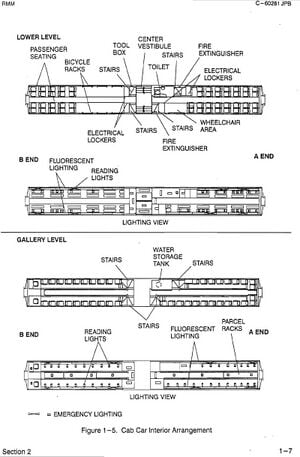
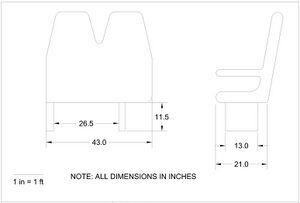
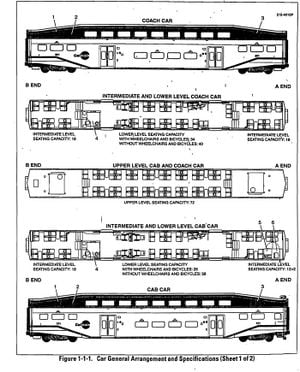
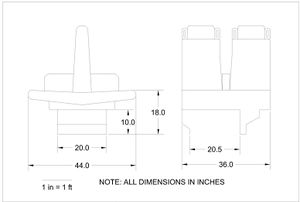
The space under train, tram and bus seating goes under utilized. This article points out that by redesigning this space it is possible to increase storage capacities on public transportation with the specific intent of making folding bike use more appealing.
Current Conditions[edit | edit source]
For my model, I used the Caltrain commuter rail system which currently runs between San Francisco and San Jose, California. This document was originally produced as a public comment for their Bicycle Master Plan, but the principles can be applied on most public transport systems.
Caltrain runs two models of passenger cars. The newer Bombardier BiLevel Coach (Bombardier Cars) and the older Nippon Sharyo gallery-type cars (Gallery Cars). The layouts for both models, with very different seat drawings are to the right ---->
Method[edit | edit source]
Data obtained for this analysis was gathered from a variety of sources:
- Layouts for the trains were obtained via reference 3.
- Dimensions for common folding bikes, were obtained from a variety of manufacturer and distributor websites for the bikes.
- Dimensions for the seats, were obtained with a measuring tape.
Design Requirement[edit | edit source]
- There must be room enough for storing the folding bikes.
- It must be possible for an average individual to get the folding bike on and off of the public transport and into its storage location with minimal hassle.
- The folding bike must be secured during transport.
- Retrofits to existing public transport must not exceed replacement of the seat (ie - cutting holes in the floor or widening the public transport are unacceptable)
Proposed Conditions[edit | edit source]
Bombardier[edit | edit source]
There are many ways to increase the available storage space. The height of this space might be increased by creating a small depression in the floor under the seat, or by making the seat under the occupant only two or three inches wide instead of eight. Access to this space might be aided by a drawer mechanism or a cantilevering seat. Also, this space might be made more useful by removing or changing the location of the under seat support. Creating this storage space would not only provide space for folding bikes but also increase space for other kinds of luggage.
As can bee seen, a reasonable retrofit of the existing Bombardier seat, could provide a space of 35"x 15"x 43" if the seat cushions were to be slimmed to 2 inches, the support moved, and 1 inch of extra space was provided in each dimension. This would accommodate most existing folding bikes.
Gallery[edit | edit source]
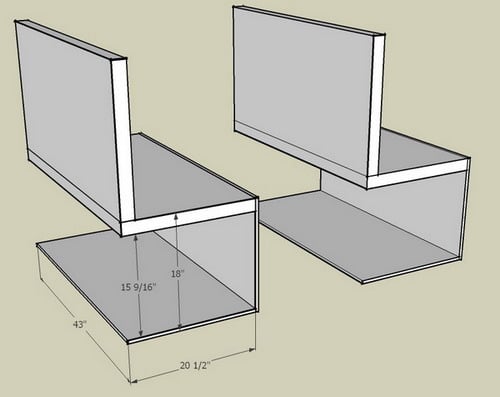
The gallery cars are more representative of the most common type of seating orientation in public transportation. In every row there are four seats separated down the middle by a narrow aisle. In each row, the people sit so that they face the back of the passengers in front of them, with their feet underneath those passengers in front of them.
My proposed design can be seen to the right. I opted to not raise the seat height at all, and slim the seat itself to only 2 inches. The support was re-designed to pass under the seat occupant's knee. In this design, the occupant would place their folding bike or other luggage under the occupant in front of them and secure that luggage by placing their feet on it.
With these changes we meet all of our design requirements:
- There is enough room to store common folding bikes.
- Assuming the layout of the public transport is amenable, it is is possible for an average individual to get the folding bike on and off of the public transport and into its stoage location with minimal hassle.
- The folding bike is secured during transport (by the owner placing their feet on it).
- Retrofits require nothing but replacing the seat. Additionally, this seat can be sold with an un-drilled bottom plate so that one model of seat can fit a number of busses and trains by allowing the municipality to drill bolt holes wherever necessary.
Bike Sizes[edit | edit source]
Below are several bike sizes that I found during a quick internet search. They are only to give the reader an idea of how big current folding bikes are. Measurements are given in inches.
| Company | Model | Height (in) | Width (in) | Depth (in) |
|---|---|---|---|---|
| Citizen Bike | Tokyo | 11 | 20 | 26 |
| Citizen Bike | Gotham | 11 | 24 | 33 |
| Citizen Bike | Miami | 11 | 24.5 | 33 |
| Brompton | M2l-nyc | 11 | 21 | 22 |
| Brompton | M3e-nyc | 11 | 21 | 22 |
| Brompton | M3l-nyc | 11 | 21 | 22 |
| Brompton | M3r-nyc | 11 | 21 | 22 |
| Dahon | Curve d3 | 12.6 | 25.2 | 29.5 |
| Dahon | Mu-p8 | 14 | 25 | 30.3 |
| Stryda | mk5 | 9 | 20 | 45 |
| GoBike | dlx8 | 15 | 26 | 30 |
| Diblasi | R24 | 8.9 | 22.8 | 25.2 |
| CarryMe | 11.8 | 10.6 | 11.8 | |
| Gecko | SPD | 8 | 28 | 28.5 |
| Kent | Superlite | 15 | 24 | 27 |
| Kent | Ultralite | 14 | 24 | 27 |
| Mobiky | Genious | 12 | 25 | 32 |
| Bike Friday | Quick Fold | 12 | 33 | 34 |
| Bike Friday | Sat D Ray | 24.5 | 28 | 42 |
| Bike Friday | Sat D Ray | 27 | 28 | 48 |
Benefit[edit | edit source]
The benefit of such a retrofit would be to increase the effective radius of service for each bus or train stop. Walking is slow and people are only willing to walk to a stop if they live within a half mile of the stop. Folding bikes would increase this radius to around 3 miles. This increase in radius means that there would need to be fewer lines to serve the same population. Also, the bus/train would have fewer stops to make, which would lead to more efficient transportation. Most importantly however, is that this improvement is dirt cheep which means that these gains can be made at what might end up being a negative cost (reducing stops and increasing ridership might provide more savings than the seats cost).
Vision[edit | edit source]
I live on Geary Blvd. in San Francisco Ca, and when I don't ride my bike, I take the 38 line (which is reported to be the most utilized bus line west of the Missippi). To get downtown, the bus stops every two blocks for (6 mi) and it takes 45min. Due to the inconvenience of this, the local transportation agency, MUNI has implemented an "express bus" which only stops 3 or 4 times and gets downtown in 25 min. I see these seets being installed on express busses like this which would greatly increase ridership on this type of bus.
Further Research/Ideas[edit | edit source]
None of this is proven. Therefore, if you are the academic type, you can do a cost analysis to try to assess what the costs and benefits of this change would imply for a transportation agency. If you are the engineering type, you can build a prototype seat to see how well the idea works. If you are a transportation agency, you can install these kinds of seets on one or two busses and run a pilot program. If you in business/manufacturing, make a company that produces these seets. If this is just another crack pot shceme, add it to the pile.
References[edit | edit source]
- http://www.mv-voice.com/morgue/2004/2004_07_16.caltrain.shtml
- http://www.sbw.org/caltrain/bike_master_plan_key_findings_public_presentation_6-08.pdf
- http://www.caltrain.com/engineeringstandards/engineering_standards/PCJPB_Stnd_for_Design_Maintenance_of_Structures_2003_web.pdf